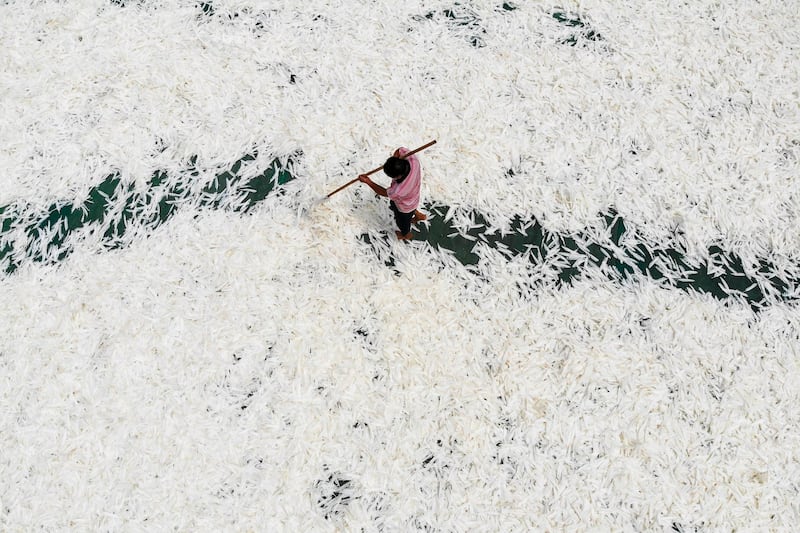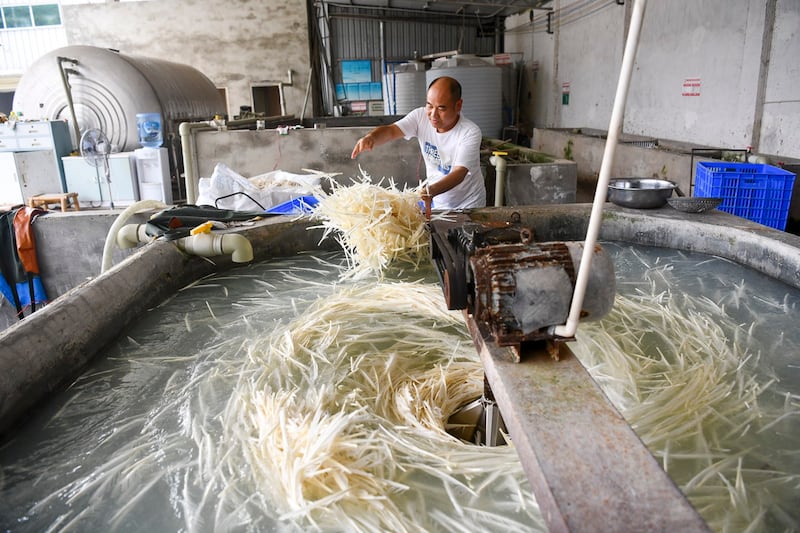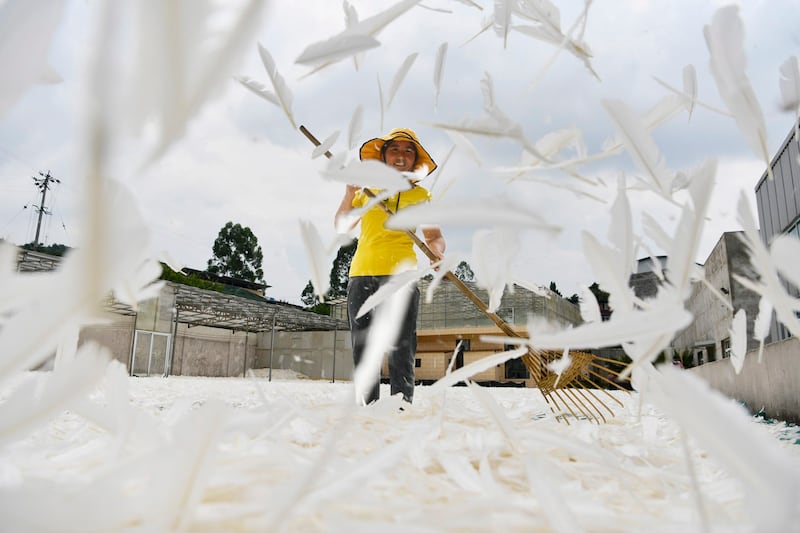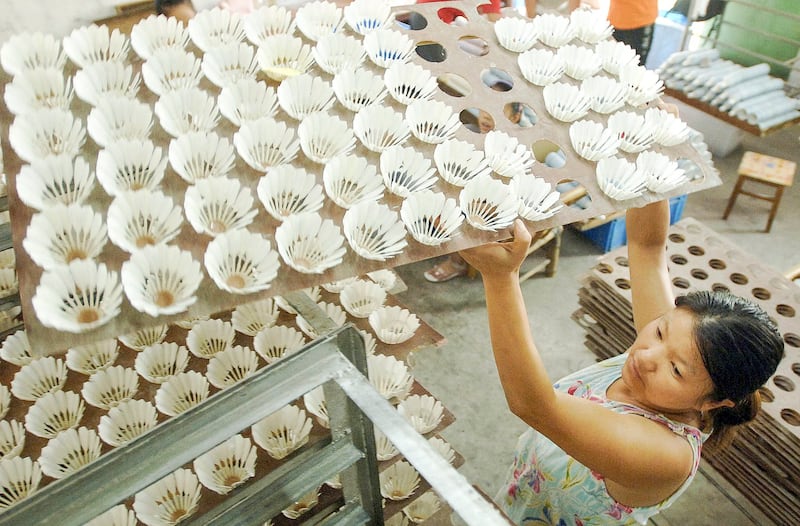As viewers around the world focus on top-flight badminton players at the Paris Olympics, bird flu and climate change in China are affecting the supply of feathers for shuttlecocks, driving prices ever higher and raising concerns about the environmental impact of the sport, experts told RFA Mandarin in recent interviews.
Around 90% of the world's feather shuttlecocks are produced in China, but prices are rising rapidly in online stores like Taobao, players said.
Japan's Yonex and Taiwan's Victor last month announced price hikes of more than 30% in six months, with a tube of 12 Yonex Aerosensa 05s rising to 275 yuan (US$38), while the price of a tube of Victor Gold No.3s has risen from 71 yuan (US$10) to 132 yuan (US$18) over the same period, the news website Shine reported on July 11.
A tube of Yonex AS-9 duck feather shuttlecocks was selling for around 160 yuan (US$22) on Taobao in April, but is now marked at 260 yuan (US$36), badminton enthusiast He Han told RFA Mandarin. "The price of shuttlecocks has been rising steadily over the past four years, but this year's price rise has been the biggest."

That quickly gets expensive for a keen player like He, who thwacks his way through 12 shuttlecocks in 4-6 hours of play.
Part of the problem is avian influenza, which has hit intensive poultry farms hard in recent years, the main source for the goose and duck feathers used to make shuttlecocks, according to Mona Lung, a policy researcher at the animal charity ACTAsia.
There are fewer geese and ducks being raised in China and fewer birds being slaughtered, leading to shortages of the right kind of feathers, Lung said.
"There are several reasons for this," she said. "The first is rising feed prices; the main feed for ducks and geese is corn."
"Then there's the emergence of a large number of mutant variants of the asian influenza virus," she said. "Intensive farming is conducive to the spread of the virus, which causes huge losses to farmers."
Falling goose and duck production
Overall, farmers are far less willing to farm geese and ducks now, Lung said.
Taiwanese sporting goods manufacturer and former athlete Hsu Shih-tsung said recent rainstorms and flooding across the eastern Chinese province of Anhui has also hit poultry farms, prompting flooding around the Dongting Lake area, while summer temperatures have soared past 40C in many places.
"Ducks and geese like a warm temperature of 30-34C when they're young, but by the third week they need temperatures of around 24C or lower, because they don't like the heat," Hsu said.
"A lot of farms don't have the right kind of shelter or ponds for them to swim in to cool down, so they become very weak, with their mouths open, which means that they are very uncomfortable."
According to statistics from the U.N.'s Food and Agriculture Organization, 90 % of the world's duck and goose production is concentrated in Asia, most of it in China.
In South Korea, which has also been baking in recent weeks, the Ministry of Public Administration and Security reported on Aug. 6 that some 277,000 head of poultry perished during the recent heat wave.

Dwindling duck and goose farming in China is also closely linked to changes in consumption patterns.
People are eating more plant-based protein, while falling pork prices mean that many more shoppers are opting for that meat over duck or goose.
According to the official Yangcheng Evening News, duck and goose production peaked in 2019, with 4.878 billion ducks and 634 million geese slaughtered, before suffering from the impact of the COVID-19 lockdowns along with the rest of the economy.
By 2023, the country saw 4.218 billion ducks and 515 million geese slaughtered, the paper said.
Team success sparks interest
Meanwhile, the success of China's Olympics team has sparked fresh enthusiasm for badminton in China, driving prices still higher.
Shuttlecocks are made from the larger wing feathers of geese and ducks, and must use feathers from the same side of the bird to ensure the finished article flies properly.
Manufacturers need 16 feathers from at least four geese to create a single shuttlecock.
In top-level competition, shuttlecocks are replaced every 1-2 minutes.
According to Hsu, not all goose and duck feathers are high enough quality.

And shuttlecocks need feathers from birds that are at least 60 days old, but ducks raised for their meat are usually slaughtered before they reach that age, Lung told RFA.
The shortage of shuttlecocks is focusing minds on the global rise of bird flu, amid recent alerts from the Food and Agriculture Organization on rising cases in animals and humans.
Poultry farmers are increasingly keeping flocks indoors for fear they will catch the disease from migratory birds, Lung said. That makes the farms hothouses for influenza outbreaks, putting staff at risk of infection, too.
And it deprives waterfowl of access to water, she said, adding that conditions in such farms are often poor and slaughterhouses don't always operate humanely.
Duck and goose farms also place huge strain on groundwater resources, sometimes to the point of causing subsidence in the land around, while the animal waste pollutes the local environment.
Take a moment to read more
[ Chinese police arrest Beijing woman for ‘defaming’ Olympic athletesOpens in new window ]
[ Tibetan athlete fails to medal in her latest Olympics but is ‘happy’Opens in new window ]
[ Chinese state TV pulls plug on Taiwan’s badminton victoryOpens in new window ]
[ Chinese social media users slam athletes over failure to deliver goldOpens in new window ]
[ Farmers weather upheaval as climate change brings a storm of challengesOpens in new window ]
[ In China, 1 in 5 could face severe drought, UN data saysOpens in new window ]
Shift to plastic shuttlecocks
The feather trade itself isn't without risk, as feathers are often soaked in blood and feces when they leave the farms, said Lung, who once had a pet duck called Bibi, calling him her "enlightenment" when it came to animal rights.
Meanwhile, moves are afoot in badminton to encourage a shift to plastic shuttlecocks.
In 2020, the Badminton World Federation approved the use of artificial shuttlecocks at international events to minimize the strain on the environment.
He Han has switched to using them, paying 80 yuan (US$11) for a pack of three, which lasts him around six hours of playing time.

Recent comments on Chinese social media platforms suggest that he's not alone in being willing to try something new.
"An industry can't stand still," one comment reads, while another agrees that "The overall trend is in favor of artificial shuttlecocks."
"Change may not bring the results we expect, but not trying means stagnation," another said, while yet another comment said: "The game is really about technical ability, which has little to do with what shuttlecock you use."
Lung is hopeful that the move to artificial shuttlecocks will gather momentum.
"Everyone should learn from the current shortage of shuttlecocks the price that is being paid for them by people, by animals, and by the environment,” she said.
Translated by Luisetta Mudie.
